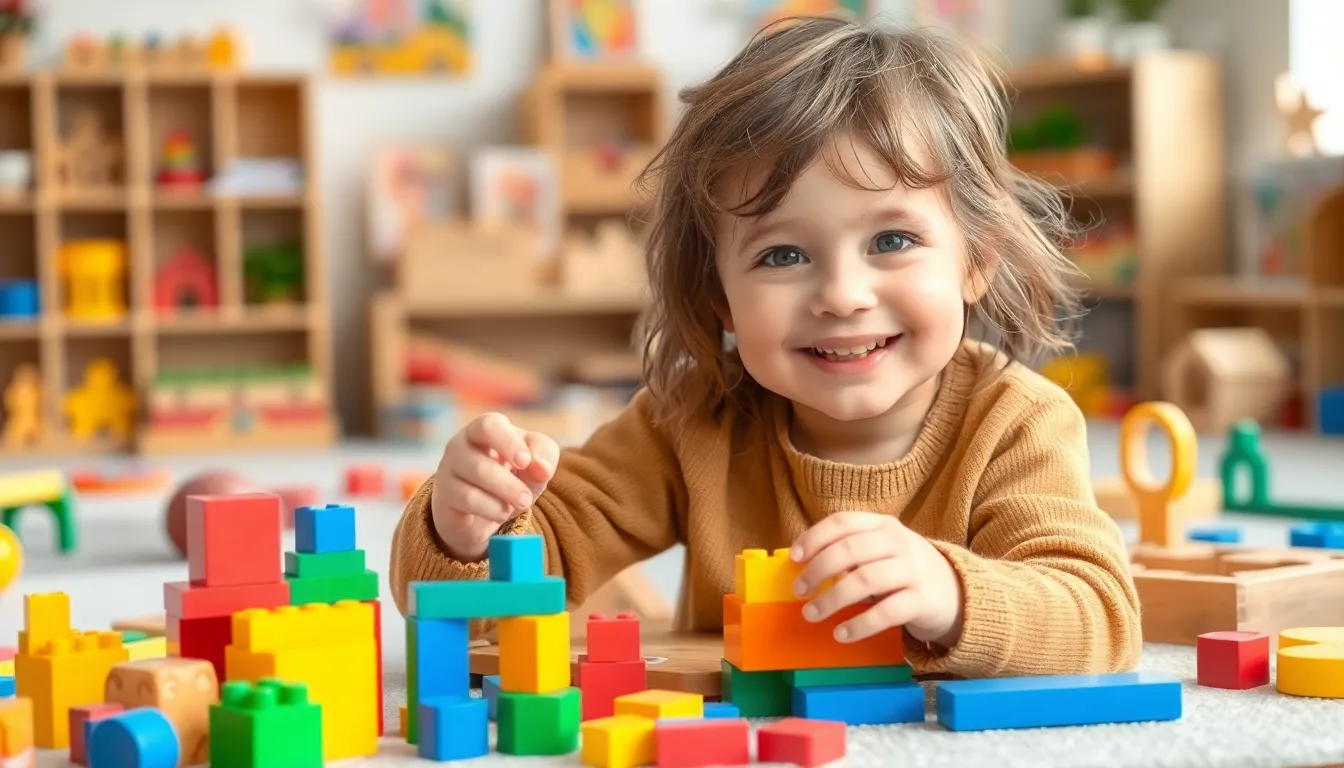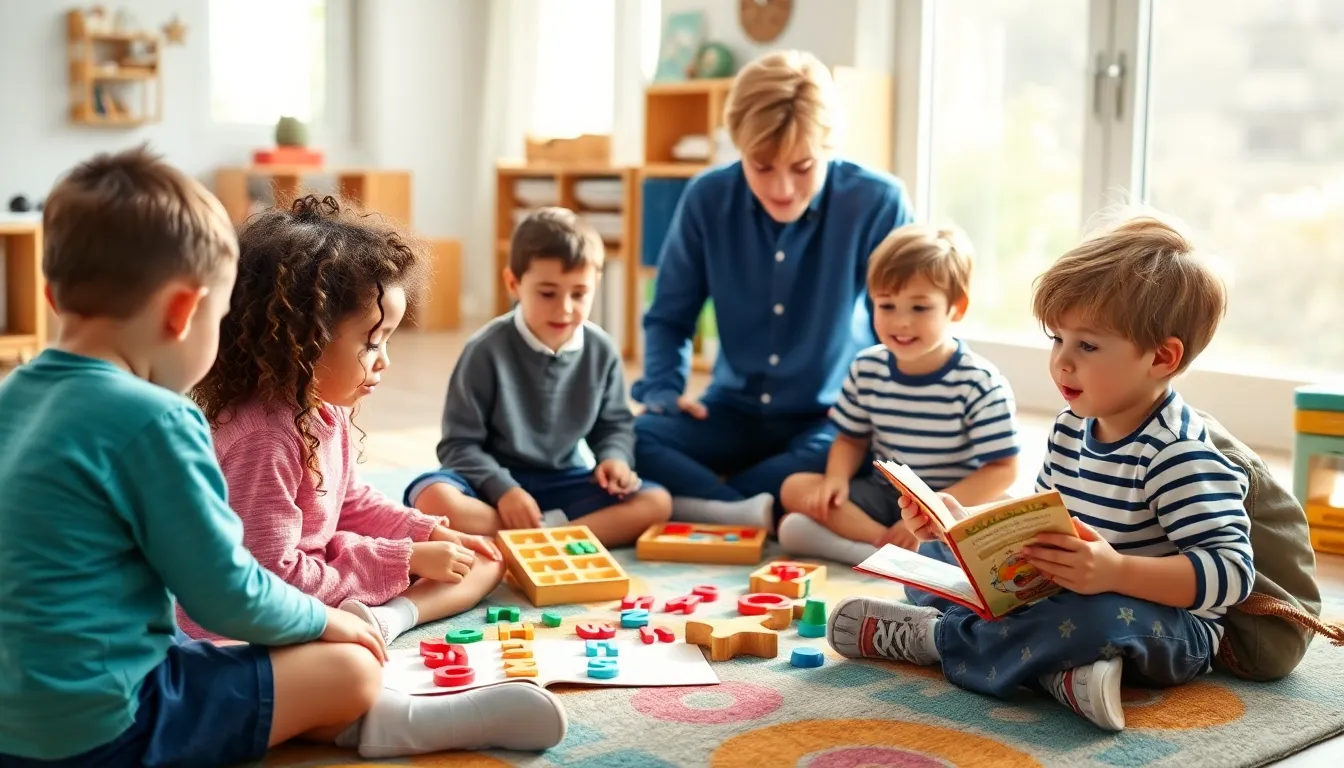In a world where toddlers often communicate through a series of grunts and adorable babbles, Montessori language development stands out as a beacon of hope for parents and educators alike. Imagine a method that not only nurtures a child’s natural curiosity but also transforms those cute sounds into eloquent expressions. Montessori isn’t just about building blocks and finger paints; it’s about laying the foundation for effective communication.
Table of Contents
ToggleUnderstanding Montessori Language Development
Montessori language development promotes communication skills through an engaging, child-centered approach. This method encourages children to explore language in ways that resonate with their natural curiosity.
The Montessori Approach to Language Learning
The Montessori approach emphasizes hands-on activities. Children learn language through sensory experiences and interactive materials. Conversational activities and storytelling enrich their vocabulary. Montessori classrooms feature language-rich environments, providing books and language games. Children often engage in peer discussions, fostering social interaction. This setting encourages them to express thoughts and emotions clearly, benefiting overall communication skills.
Key Principles of Montessori Education in Language
Respect for each child’s individual pace is a fundamental principle. Children receive tailored guidance, ensuring they feel confident in their language development. Hands-on learning activities support meaningful engagement. The method prioritizes the development of fine motor skills through writing and vocabulary work. Children learn in mixed-age groups, promoting collaboration and mentorship. This collaborative environment nurtures verbal skills and builds self-esteem, crucial to effective communication.
Stages of Language Development in Montessori

Montessori language development encompasses various stages that promote effective communication in children. Each stage emphasizes different activities, refining children’s language skills in a nurturing environment.
Sensorial Language Activities
Sensorial language activities engage children’s senses, fostering vocabulary acquisition through tactile experiences. Children explore objects, colors, and textures, enriching their descriptive language. Using materials like the pink tower or color tablets, children learn to articulate their observations. They describe shapes and sizes, enhancing their ability to communicate complex ideas. Such activities cultivate an understanding of language through direct interaction with the world around them.
Practical Life and Language Skills
Practical life activities provide essential context for language development. Children engage in everyday tasks like pouring, sweeping, and dressing, while they develop vocabulary associated with actions and objects. These tasks encourage children to communicate their intentions and experiences. Verbalizing steps in practical activities strengthens their ability to express needs and thoughts. Community involvement during these tasks further enhances their conversational skills and fosters social interaction.
Introduction to Reading and Writing
Introducing reading and writing forms a critical aspect of Montessori language development. Children start with phonetic awareness, using sandpaper letters for tactile learning. This method allows them to connect sounds with symbols, facilitating early writing skills. Through storytelling and picture books, children develop comprehension and narrative skills. Engaging in group reading fosters collaboration, nurturing a love for literature alongside effective communication. These components create a strong foundation for lifelong literacy.
Benefits of Montessori Language Development
Montessori language development offers numerous advantages for children as they nurture communication skills. This approach encourages self-paced learning and supports various aspects of language acquisition.
Fostering Independence and Confidence
Independence emerges as children engage in self-directed language activities. They explore words and phrases at their own pace, instilling a sense of confidence in their ability to communicate. Setting personal language goals enhances motivation, empowering children to express themselves freely. As they interact with peers in mixed-age groups, they learn from each other, reinforcing their own understanding. Children also gain confidence through hands-on writing experiences, which foster fine motor skills while allowing them to convey thoughts effectively.
Encouraging Communication Skills
Communication skills flourish in a Montessori environment enriched with language materials. Children participate in storytelling and discussions, crucial activities that enhance their ability to articulate ideas. Engaging with books broadens vocabulary and stimulates comprehension. Conversational interactions promote social skills and emotional expression, vital components of effective communication. Moreover, peer collaborations encourage them to practice verbal skills in a supportive setting. Each of these elements contributes to a holistic development of language abilities, equipping children for future interactions.
Implementing Montessori Language Activities at Home
Enhancing language development at home follows Montessori principles effectively. Engaging with children encourages their exploration of language through everyday activities.
Practical Tips for Parents
Encourage storytelling during daily routines. Conversations during meals and outings provide rich opportunities for language development. Use descriptive language to expand vocabulary, pointing out colors, shapes, and sizes. Incorporate language games that promote recognition of letters and sounds. Create a consistent reading routine, introducing a variety of age-appropriate books. Invite children to engage in discussions about stories, allowing them to express thoughts and ask questions. Set goals for individual language skills, fostering a sense of achievement. Lastly, celebrate progress to boost motivation and confidence.
Recommended Resources and Materials
Select interactive books that spark interest and imagination. Choose materials that align with Montessori philosophy, such as letter tiles and sound puzzles. Utilize storytelling cards to inspire creative expression. Consider language-rich toys that facilitate conversation, like puppets or action figures. Incorporate sensory experiences with textured letters or picture cards. Explore mobile apps designed for literacy, prioritizing those with a hands-on approach. Finally, seek community resources, such as libraries or local reading programs, to enhance exposure and interaction with language.
Montessori language development offers a transformative approach to nurturing communication skills in young children. By fostering a rich language environment and encouraging exploration through hands-on activities, it cultivates a child’s natural curiosity. The emphasis on self-paced learning and tailored guidance builds confidence and independence in language use.
Parents can play a crucial role in this journey by incorporating Montessori principles into daily routines. Engaging in storytelling and using descriptive language can significantly enhance vocabulary and comprehension. With the right resources and a supportive environment, children can thrive in their language development, setting the stage for effective communication throughout their lives.




